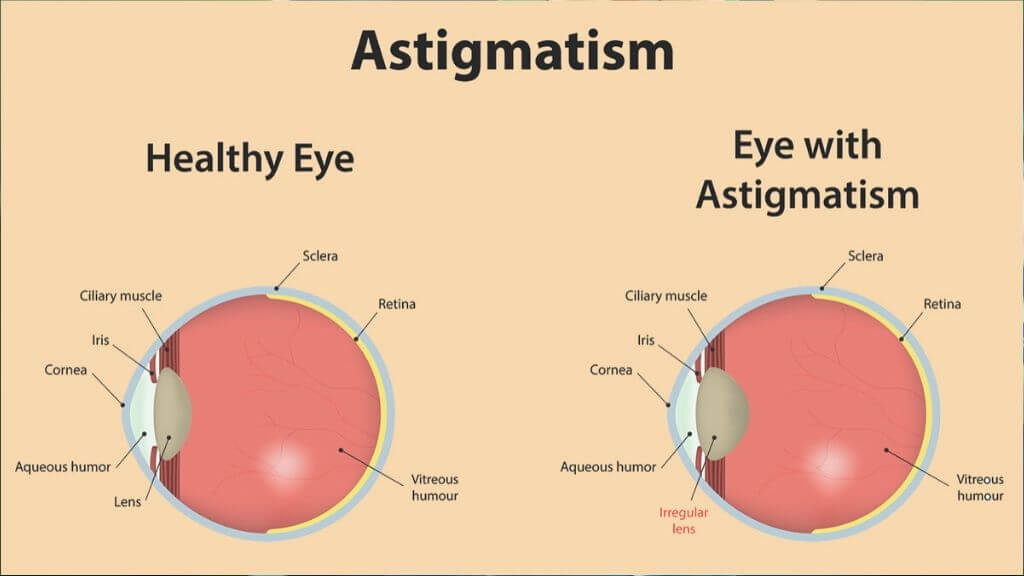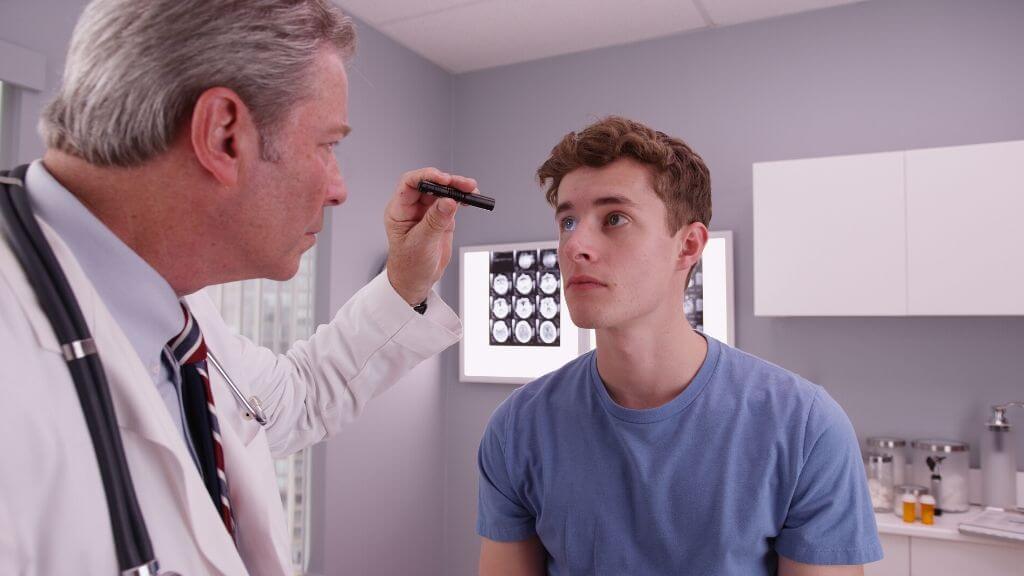Double vision, or diplopia, is a condition that causes you to see two images instead of one. The two images seen can be on top of each other or side by side.
This condition can interfere with your quality of life, as it affects balance, movement, and reading. There can be serious complications of double vision if left untreated. The cause is usually an underlying condition, which needs to be identified and treated to avoid more health issues.
There are two types of diplopia. When double vision affects one eye, it is monocular. When it affects both eyes, it is binocular. It’s important to know which type you have as this affects treatment, and this can be determined with a simple test. Cover one eye while the double vision is occurring. For monocular diplopia, the double vision will go away when the affected eye is covered.
Symptoms of Double Vision
Double vision presents as images that appear to overlap. It can also cause you to feel dizzy and affect your balance.
Double vision can also be variable, so it may not be present all the time. When a problem with the surface of the eye is the case, blinking can temporarily clear double vision. With binocular diplopia, the direction of the head can dictate when double vision is present.
In severe cases, diplopia can also cause more serious symptoms, such as:
♦ Vertigo
♦ Nausea
♦ Sensitivity to light
♦ Headaches
Causes of Double Vision
Double vision is typically caused by an underlying condition. Monocular double vision is the result of an eye problem. Binocular double vision indicates a problem within your brain or nervous system.

The causes of double vision can range from mild to life-threatening. There are also cases of temporary double vision that can be caused by excessive alcohol consumption or the use of certain medications like opioids.
Conditions Associated with Monocular Double Vision
This is less common than binocular double vision and indicates a problem with the eye. Individuals report seeing one object clearly, while the other is faded. The most common causes of monocular double vision include:
♦ Severe astigmatism: Astigmatism is an imperfection in the curvature of the eye. Blurred vision and double vision are common symptoms. Astigmatism is typically treated with prescription glasses.
♦ Cataracts: A cataract causes the lens of your eye to become cloudy, which causes vision problems. Our vision becomes cloudy over time. You can also develop a double vision as vision becomes more obstructed.
♦ Dry eyes: Dry eyes develop when your eyes are no longer able to produce lubricating fluids. These fluids are essential for keeping the eye moist, and they make blinking and moving your eye more comfortable. When there is not enough fluid, your eyes become itchy and irritated. You may also experience double vision.
Conditions Associated With Binocular Double Vision
Binocular double vision will go away when you cover one eye. This is because the condition is caused by both eyes not working together. With binocular double vision, individuals report that two images they see are both clear. The most common causes for this type include:
♦ Nerve damage: The nerves in your eyes transmit information to your brain. Any injury or inflammation to the nerves can cause double vision and other visual problems.
♦ Diabetes: Uncontrolled blood glucose levels can cause an eye disease known as diabetic retinopathy. This can cause double vision and eventually loss of vision, if not treated.
♦ Cranial nerve palsy: Your cranial nerves run along the surface of your brain. As with all nerves, these can become paralyzed, usually as the result of an injury. Vision problems like double vision can occur. Diabetes and high blood pressure can also cause paralysis to the cranial nerves.
♦ Grave’s disease: Grave’s disease is an immune system disorder caused by an overactive thyroid. Many people with this condition develop some type of vision problem, and double vision is one of the most common.
Life-threatening conditions such as strokes, aneurysms, and cranial tumors can also cause vision problems. Double vision is often a symptom of a potential problem that needs immediate medical attention. In the case of strokes, double vision can be a lasting side effect during recovery.
Diagnosing Double Vision
It is a straightforward process to diagnose double vision, but identifying the cause is more complicated. Discussing all symptoms and visual experiences with your doctor can help this process.
After an eye exam confirms double vision, testing will be done to find a cause. This testing usually involves different steps.
♦ Current health: Your doctor needs to get an updated account of your health history. Visual symptoms are most important, as well as other unusual symptoms that are new. Any personal health information is relevant, such as any diseases or disorders. Thyroid problems, neurological disorders, and diabetes can all impact eye health. It is also important to discuss vision problems in your family.
♦ Physical examination: A series of tests are done to identify the cause of your double vision. Blood tests look for infections and scans, and imaging tests are performed to look for damage. Your doctor will also dilate your pupils to look into the back of your eye and perform eye movement tests.

Double Vision Treatment
Successful treatment of double vision depends on the underlying cause. In most cases, double vision goes away once the underlying cause has been addressed. The most common treatments for double vision include:
♦ Corrective lenses: Prescription eyeglasses or lenses are given to correct the vision problem. Some lenses have prisms etched onto them to adjust vision.
♦ Eye patch: Covering one eye is known to correct double vision. This is more of a temporary solution.
♦ Eye exercises: Double vision that results from strained eye muscles can be corrected with exercises. Your doctor can provide you with these exercises, and once stronger, your vision should improve.
♦ Surgery: Surgery can be an option depending on the problem. Any physical issues like cataracts or problems within the eye structure will need surgery. Once the problem is corrected, double vision should go away.
Natural Treatment for Double Vision
Many of the causes of double vision can be treated. You can also prevent them with the use of natural compounds and supplements. Certain nutrients and minerals protect the eyes and reduce the risk of eye conditions that can cause double vision.
The most important natural treatments for eye health and reduced risk of double vision include the following ingredients:
♦ EVTene™: An essential mix of carotenoids to boost eye health. Alpha-carotene, beta-carotene, and lycopene work to prevent oxidative stress. Each carotene has its own benefits, making this combination an efficient way to support eye health. For example, lycopene has been linked to a reduced risk of cataract development.
♦ Astaxanthin: This antioxidant compound found in seafood is similar in structure to beta-carotene. Astaxanthin has been found to reduce the risk of serious eye diseases like macular degeneration. More powerful than vitamin E, astaxanthin prevents cell damage that causes poor vision.
Diabetic retinopathy is a serious condition that can be prevented. Along with monitoring blood glucose levels, you need to promote eye health. Zeaxanthin is one of the best natural ingredients to do this.
Zeaxanthin is found naturally in the eye around the retina. It provides antioxidant protection to this important part of the eye. Regular consumption will reduce the risk of diabetic retinopathy and retinal detachment, both of which are associated with double vision.
When to See Your Doctor
Double vision accompanied by headaches and severe eye pain can indicate a life-threatening emergency. Double vision can indicate a serious problem with your eye, brain, or nervous system, but it’s most likely the result of a treatable condition.
A complete evaluation is the only way to determine the cause. Sudden changes, however, need immediate attention. Without evaluation and prompt treatment, the risk for permanent vision loss is higher.






